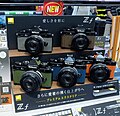 Nikon Zf + NIKKOR Z 40mm f/2 SE | |
| Overview | |
|---|---|
| Maker | Nikon |
| Type | Mirrorless interchangeable lens camera |
| Released | 27 October 2023 [1] |
| Lens | |
| Lens mount | Nikon Z-mount |
| Sensor/medium | |
| Sensor type | BSI-CMOS Sensor |
| Sensor size | 35.9 mm × 23.9 mm Full Frame (Nikon FX format) |
| Sensor maker | Sony Semiconductor Manufacturing Corporation |
| Maximum resolution | 6,048 × 4,032 (24.5 effective megapixels) |
| Film speed | ISO 100–64000 (standard) ISO 100–204800 (expandable) |
| Recording medium | 1 × SD (UHS-II), 1 × microSD (UHS-I) |
| Focusing | |
| Focus | Hybrid AF |
| Focus areas | 273 points |
| Exposure/metering | |
| Exposure | TTL exposure metering |
| Exposure modes | Programmed Auto [P] with flexible program; Shutter-Priority Auto [S]; Aperture Priority Auto [A]; Manual [M] |
| Exposure metering | TTL exposure metering |
| Flash | |
| Flash | Built-in: No Hot shoe |
| Shutter | |
| Shutter | Electronically controlled vertical-travel focal-plane mechanical shutter, Electronic front-curtain shutter, Electronic Shutter |
| Shutter speeds | 30s – 1/8000s, Bulb, Time, X |
| Continuous shooting | 7.8fps / 14fps (expand) |
| Viewfinder | |
| Viewfinder | 0.5 inch Quad-VGA OLED EVF (3,690,000 'dots') |
| Image processing | |
| Image processor | EXPEED 7 |
| General | |
| Video recording | 4K UHD at 30p/25p/24p, Full HD at 120p/100p/60p/50p/30p/25p/24p |
| LCD screen | 3.2-inch variangle TFT LCD with touchscreen, 2.10 million dots |
| Battery | EN-EL15c (EN-EL15b/a usable with reduced battery life) USB-PD rechargeable |
| Optional accessories | MC-N10 remote grip |
| AV port(s) | USB Type-C, HDMI Type-D, Stereo mini jack (3.5mm) for headphone and mic out |
| Data port(s) | IEEE 802.11b/g/n/a/ac/Wi-Fi, Bluetooth 5.0 |
| Body features | In-Body Image Stabilization |
| Dimensions | 144×103×49 mm (5.7×4.1×1.9 in) |
| Weight | 630 g (22 oz) (body only) 710g (includes battery) |
| Latest firmware | 3.00 / 28 October 2025 [2] |
| Made in | Thailand |
| Chronology | |
| Predecessor | Nikon Df Nikon Z6II Nikon Zfc |
The Nikon Zf is a mirrorless interchangeable-lens camera with the Nikon Z-mount with a list price of $1999 body only, in the US. [3] [4] It is the eleventh Z-mount camera body and the eighth full-frame Z-mount body.










